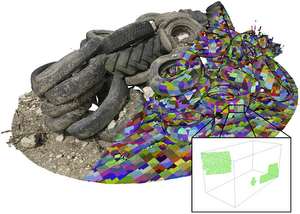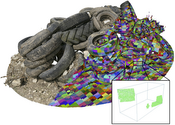Information
- Publication Type: Journal Paper with Conference Talk
- Workgroup(s)/Project(s):
- Date: July 2022
- Journal: Proceedings of the ACM on Computer Graphics and Interactive Techniques
- Volume: 5
- Open Access: yes
- Number: 3
- Location: Vancouver
- Lecturer: Markus Schütz
- ISSN: 2577-6193
- Event: High Performance Graphics 2022
- DOI: 10.1145/3543863
- Call for Papers: Call for Paper
- Pages: 17
- Publisher: Association for Computing Machinery (ACM)
- Conference date: 11. July 2022 – 14. July 2022
- Pages: 1 – 17
- Keywords: point-based rendering
Abstract
We propose a software rasterization pipeline for point clouds that is capable of brute-force rendering up to two billion points in real time (60fps). Improvements over the state of the art are achieved by batching points in a way that a number of batch-level optimizations can be computed before rasterizing the points within the same rendering pass. These optimizations include frustum culling, level-of-detail rendering, and choosing the appropriate coordinate precision for a given batch of points directly within a compute workgroup. Adaptive coordinate precision, in conjunction with visibility buffers, reduces the number of loaded bytes for the majority of points down to 4, thus making our approach several times faster than the bandwidth-limited state of the art. Furthermore, support for LOD rendering makes our software-rasterization approach suitable for rendering arbitrarily large point clouds, and to meet the increased performance demands of virtual reality rendering.Additional Files and Images
Weblinks
BibTeX
@article{SCHUETZ-2022-PCC,
title = "Software Rasterization of 2 Billion Points in Real Time",
author = "Markus Sch\"{u}tz and Bernhard Kerbl and Michael Wimmer",
year = "2022",
abstract = "We propose a software rasterization pipeline for point
clouds that is capable of brute-force rendering up to two
billion points in real time (60fps). Improvements over the
state of the art are achieved by batching points in a way
that a number of batch-level optimizations can be computed
before rasterizing the points within the same rendering
pass. These optimizations include frustum culling,
level-of-detail rendering, and choosing the appropriate
coordinate precision for a given batch of points directly
within a compute workgroup. Adaptive coordinate precision,
in conjunction with visibility buffers, reduces the number
of loaded bytes for the majority of points down to 4, thus
making our approach several times faster than the
bandwidth-limited state of the art. Furthermore, support for
LOD rendering makes our software-rasterization approach
suitable for rendering arbitrarily large point clouds, and
to meet the increased performance demands of virtual reality
rendering. ",
month = jul,
journal = "Proceedings of the ACM on Computer Graphics and Interactive
Techniques",
volume = "5",
number = "3",
issn = "2577-6193",
doi = "10.1145/3543863",
pages = "17",
publisher = "Association for Computing Machinery (ACM)",
pages = "1--17",
keywords = "point-based rendering",
URL = "https://www.cg.tuwien.ac.at/research/publications/2022/SCHUETZ-2022-PCC/",
}


 paper
paper
